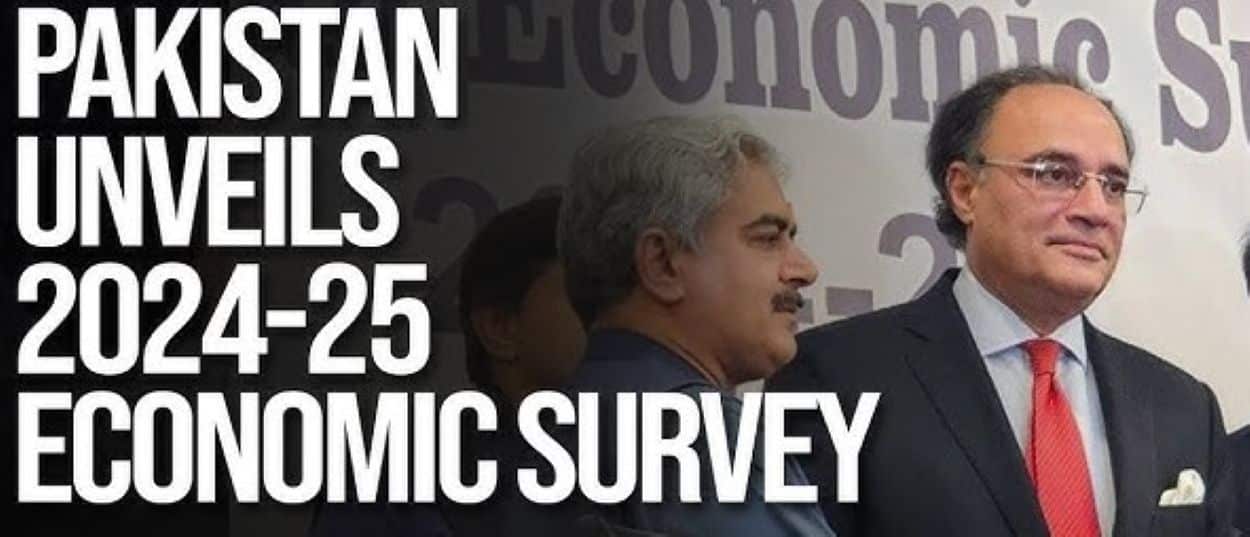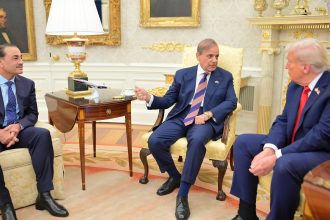On June 9, 2025, Pakistan’s Finance Minister Muhammad Aurangzeb unveiled the Pakistan Economic Survey 2024-25 in Islamabad. This critical pre-budget document details the country’s socio-economic performance for the fiscal year (July 1, 2024, to June 30, 2025).
The Ministry of Finance Pakistan Economic Survey highlights a year of macroeconomic stabilisation, with a GDP growth of 2.7%, significant inflation control, and improvements in fiscal and external accounts. Despite missing the 3.6% growth target, the survey positions Pakistan for medium-term recovery, supported by structural reforms and initiatives like the Special Investment Facilitation Council (SIFC) and the URAAN Pakistan plan. This analysis verifies the survey’s key points and provides insights into Pakistan’s economic trajectory.
Economic Performance
GDP Growth
The survey reports a real GDP growth of 2.7% for FY 2024-25, slightly below the ambitious 3.6% target but an improvement from 2.5% in FY 2024 and -0.2% in FY 2023 Dawn. Quarterly growth rates were 1.37% (Q1), 1.53% (Q2), and 2.4% (Q3), requiring a 5.5% growth in Q4 to meet the annual target. This modest growth reflects a gradual recovery amidst global economic challenges.
Sectoral Contributions
Varied sectoral performances drove the economy’s growth:
- Services Sector: Grew by 2.91%, up from 2.2% in FY 2024, driven by wholesale, retail trade, finance, and information and communications (6.5% growth).
- Industrial Sector: Achieved a robust 4.77% growth, surpassing the 4.4% target, with large-scale manufacturing, particularly in automobiles and export-oriented industries, rebounding strongly. Construction also grew by 6.6%.
- Agriculture Sector: Recorded a modest 0.56% growth, constrained by a 13.5% decline in major crop production. However, other crops like fruits and vegetables grew by 4.78%, livestock by 4.72%, fisheries by 1.42%, and forestry by 3.03% Ministry of Finance.
| Sector | Growth Rate (FY 2025) | Previous Year (FY 2024) |
|---|---|---|
| Services | 2.91% | 2.2% |
| Industry | 4.77% | -1.4% |
| Agriculture | 0.56% | Not specified |
Inflation and Monetary Policy
Inflation experienced a significant decline, reaching a record low of 0.3% in April 2025, down from 17.3% the previous year. For the period from July to April in FY 2025, the average Consumer Price Index (CPI) inflation was recorded at 4.7%, well below the 12% target. This achievement was made possible through:
- Tight monetary policies, with the policy interest rate reduced to 11% due to improved fundamentals.
- Exchange rate stability.
- Administrative measures include curbing hoarding and expanding subsidised markets.
Fiscal Performance
Fiscal discipline improved significantly:
- Fiscal Deficit: Narrowed to 2.6% of GDP for the first nine months of FY 2025, down from 3.7% in FY 2024.
- Primary Surplus: Reached Rs 3,468.7 billion (3.0% of GDP).
- Tax Revenues: Surged by 26.3%, reaching Rs 9,300.2 billion (July-April FY 2025), compared to Rs 7,361.9 billion the previous year.
- Non-Tax Revenues: Increased by 68%, driven by higher profits from the State Bank of Pakistan and petroleum levies Ministry of Finance.
External Account
The external sector showed resilience:
- Current Account: Recorded a surplus of US$ 1.9 billion during July-April FY 2025, reversing a US$ 1.3 billion deficit from the previous year.
- Remittances: Remittances increased by 30.9%, reaching a record US$4.1 billion in March 2025. The expected annual total is US$37-38 billion, up from US$31 billion in FY 2024.
- Foreign Exchange Reserves reached US$16.64 billion by May 27, 2025, reflecting improved external stability, the Ministry of Finance.
Investment and Savings
Investment and savings trends indicate growing economic confidence:
- National Savings: Stood at 14.1% of GDP, slightly above investment at 13.8%, resulting in a foreign savings surplus of 0.4%.
- Private Investment: Grew by 9.9%.
- Public Investment: Including government development spending, rose by 34.2%.
- Gross Fixed Capital Formation (GFCF): Reached Rs 13,814.7 billion, up 15.0% from FY 2024.
| Indicator | FY 2025 | Previous Year (FY 2024) |
|---|---|---|
| National Savings (% of GDP) | 14.1% | Not specified |
| Investment (% of GDP) | 13.8% | Not specified |
| Private Investment Growth | 9.9% | Not specified |
| Public Investment Growth | 34.2% | Not specified |
| GFCF (Rs billion) | 13,814.7 | Not specified |
AI and Economic Transformation
The survey emphasizes Pakistan’s potential to leverage artificial intelligence (AI) for economic growth, given its young demographic and expanding digital consumer base. However, challenges include gaps in digital infrastructure and skills. The government is addressing these through the National Economic Transformation Plan, which prioritizes:
- Enhancing digital infrastructure.
- Developing AI-ready skills.
- Promoting innovation and technology adoption Ministry of Finance.
Global Context and Challenges
The global economy is projected to grow at 2.8% in 2025, down from 3.5% in 2023, according to the IMF’s World Economic Outlook, cited in the survey Dawn. Key global challenges include:
- Trade tensions and protectionist policies.
- Geopolitical uncertainties.
- Volatile financial markets.
Pakistan faces risks from reduced export demand, particularly in textiles, but is mitigating these through:
- Fiscal consolidation.
- Energy pricing reforms.
- Initiatives like the Special Investment Facilitation Council (SIFC) to attract investment.
- The URAAN Pakistan plan is likely focused on urbanisation and infrastructure development.
The survey underscores Pakistan’s commitment to structural reforms, including:
- Expanding the tax base.
- Privatising state-owned enterprises.
- Issuing climate finance instruments like the Green Sukuk.
With ongoing IMF support and improved macroeconomic indicators, Pakistan aims for sustainable and inclusive growth. However, challenges such as climate risks, global economic slowdowns, and domestic infrastructure gaps remain critical hurdles.
The Pakistan Economic Survey 2024-25 reflects a year of macroeconomic stabilisation, with a 2.7% GDP growth, controlled inflation at 4.7%, and a strengthened external account. Though global and domestic challenges persist, focusing on AI, fiscal discipline, and investment growth positions Pakistan for medium-term recovery.






